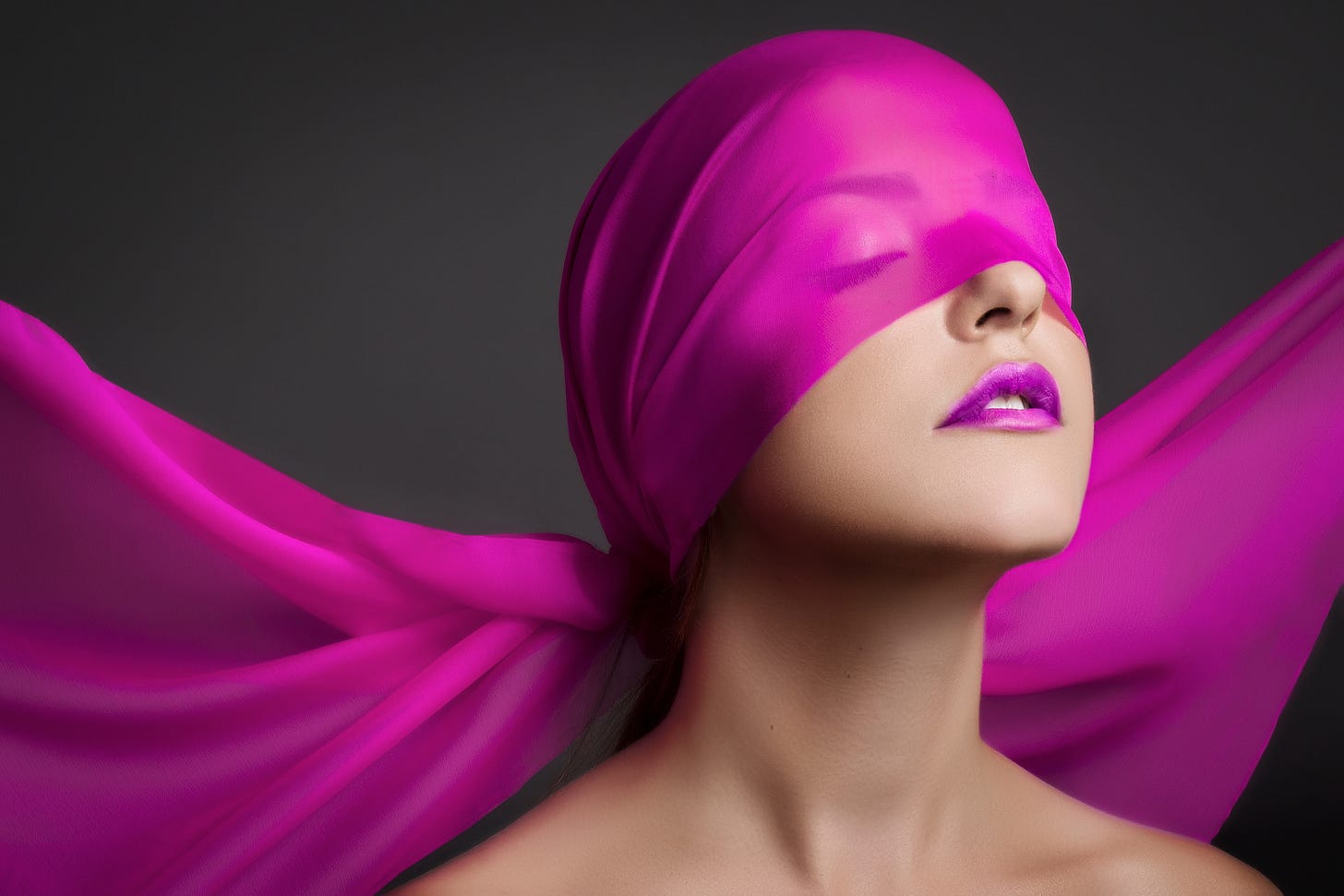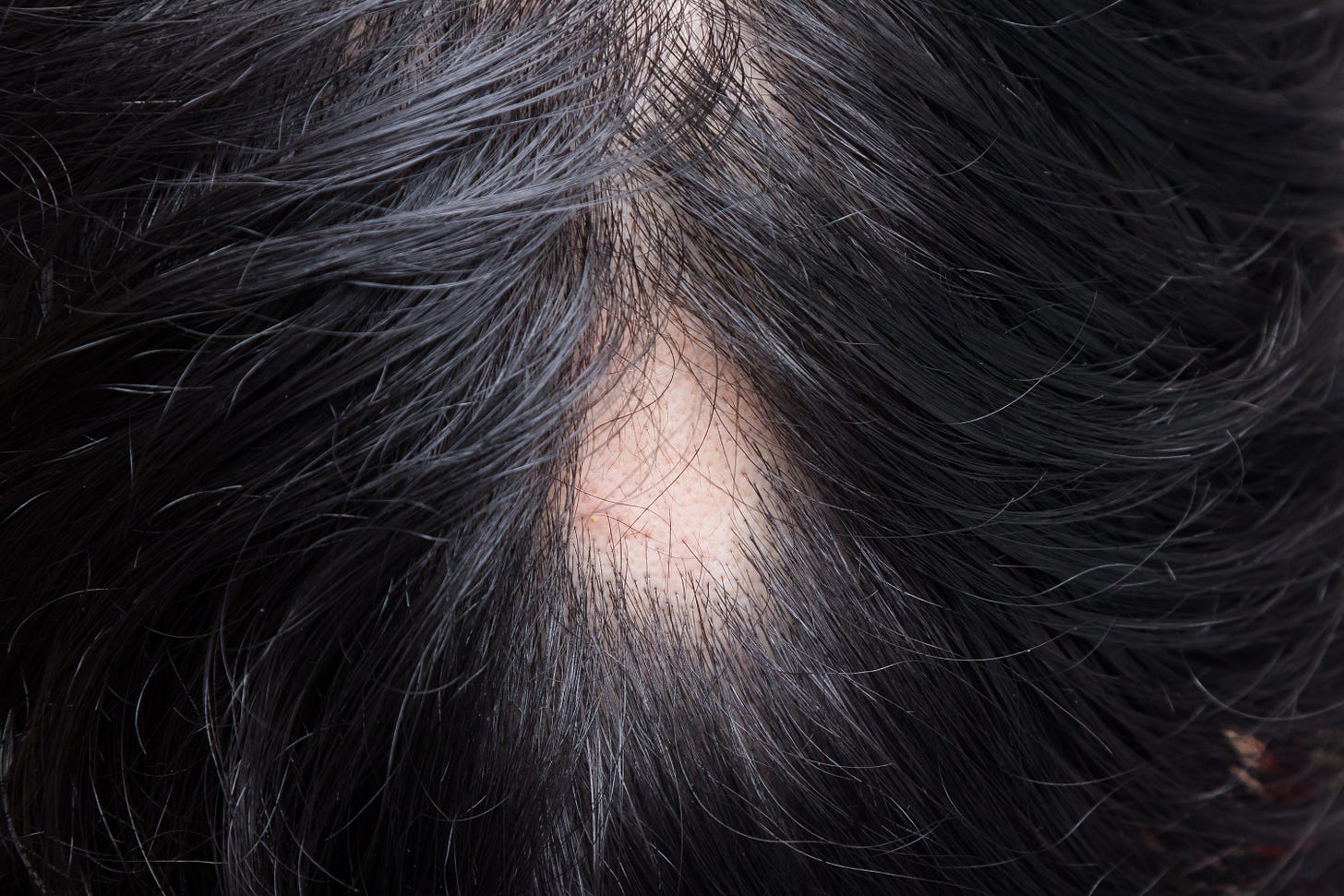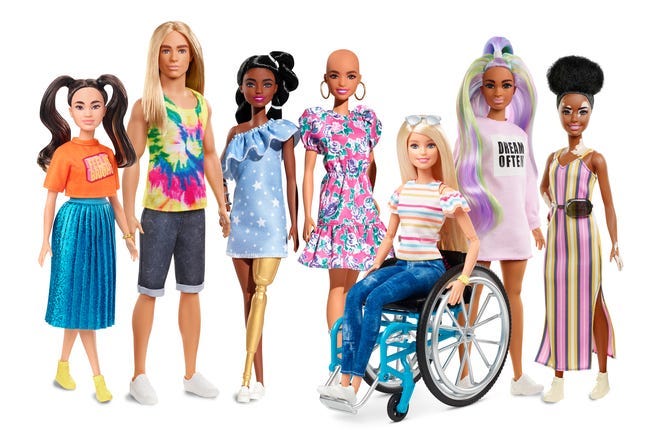When I was eight, one day, my left eyebrow and the skin around it turned white. Soon, I lost my eyebrows and my hairline receded from all directions in a “wavy” pattern rapidly. 20 years later, I learned that I had a rare version of alopecia areata, called “ophiasis” (which means “snake”).
Today, we know that vitiligo (skin turning white) and alopecia areata are two types of autoimmune diseases that share many similarities in their disease formation. But back then, when living in China in the 90s, my parents didn’t take me to the doctor. Frankly, I am not sure if they did, anyone would have done anything except give me steroids.
But I’m not the girl who lost all her hair.
Mimi was an 18-year-old timid girl who couldn’t wait to shrink herself into the corner of the exam room when I met her. She only had (literally) three strands of hair left thanks to severe alopecia areata.
Her previous doctors tried all sorts of things: topical steroids, steroid scalp injections, and steroid pills. Nothing worked.
Treating alopecia areata (AA) is not always easy:
AA is an autoimmune disease. This means the immune system spontaneously attacks the hair follicles, causing them to stop functioning.
Small areas of AA often go away on their own within a year without any treatment; so a lot of times, if the patient can hide it, I try to reassure them.
In kids who have small areas, we can treat it with mid to high-potency steroid creams or liquid, such as triamcinolone or clobetasol.
If patients can tolerate it and the areas of AA are less than 25% of their scalp, I offer injections (with a very thin needle) with steroids. This is not the same as steroid shots! This is just the medicine injected into the skin, not the whole body. I get these myself all the time when I have new spots!
The steroids applied onto or injected into the skin can cause “atrophy” — meaning the skin might thin, and there can be a little concave/sank-down. But usually, this is temporary.
A “new kid on the block” is topical immunotherapy. Some doctors apply a liquid to the scalp periodically in the office that causes skin inflammation, which “distract” the immune system from attacking the hair follicles.
In the past, oral steroids like prednisone were used often for severe AA. We all know that taking steroids has a lot of side effects such as suppressing the immune system, weight gain, and even stunting growth in kids. So when this is used, it should be for a short term.
Even with all of these, sometimes, treatment can often be unsuccessful. The larger the areas are, the less likely a full recovery will happen.
Fancy New Drugs (biologics):
Increasingly, for extensive disease, doctors are considering oral Janus kinase (JAK) inhibitors. These are medications that target specific enzymes that contribute to these disease processes.
In 2022, the FDA approved baricitinib (Olumiant®) for adults with severe AA. Clinical trials showed that 38.8% of patients had hair regrowth where over 80% of their scalp was covered again after 9 months. And this result seemed to maintain over time.
Then, in June 2023, ritlecitinib (Litfulo®) was approved by the FDA for severe AA for patients over 12 years of age, marking it the first approved medication for adolescents! In the clinical trials, 31% of patients achieved over 80% scalp hair coverage after six months of high-dose ritlecitinib.
Both Olumiant and Lifulo are once-a-day pills.
But…
“The only problem is, insurance companies don’t like to pay for these expensive medications.” Mimi was a great candidate for these new drugs and I desperately wanted to help her. But I also knew I wasn’t the one paying for her medications.
According to drugs.com, without insurance’s help, a one-month supply of Olumiant costs $2,894.71 at standard dose, and $5,779.92 a month if a higher dose is needed. And the monthly price for Litfulo is $3,978.50.
Mimi was from a working-class immigrant family. She had state insurance. This was going to be an uphill battle. But in all honesty, every day, I wish these medications were available when I needed them. And every day, I wish someone went to “battles” with me to get them for me.
So, there started my “good fight” with the insurance company. I won’t bore you with it here. But after 2 months and 6 denials from the insurance…the fight goes on. If you want to know how I REALLY feel about insurance companies (I suspect that’s also how you feel about them), you can read the full story here. Please leave me a word of encouragement if you do…!!
Other treatments that might help hair growth in general:
Rogaine, or minoxidil.
This over-the-counter medicine has been used for male/female pattern hair loss for a long time.
It might work by prolonging the growing period of hair.
When used “off label” for other types of alopecia such as AA, the studies are inconclusive.
5% liquid (Rogaine for men) might work better than 2% (Rogaine for women) for both men and women
When I tried it, it really irritated my scalp. So I tell patients to try it on a small area of the scalp first before putting it all over the head.
Some people shed more when first starting Rogaine. This typically stops in a few weeks. So, don’t freak out.
Minoxidil has a pill form, but it’s not for everyone.
Antifungal shampoo
Ketoconazole shampoo 2% can be prescribed, and 1% can be purchased in-store
Some evidence shows that these antifungal shampoos can help hair regrowth even when the problem isn’t fungus/yeast/dandruff. I think of it as “optimizing the soil” for more hair to come. But research shows that it might deserve more credit than that.
Biotin ($don’t waste your money$)
For most people, biotin doesn’t work.
In fact, taking too much of it might actually mess up important lab values such as hormones and even heart attack numbers!
It’s ok to feel stressed
Stress can make you lose hair. And I don’t mean just emotional stress. Taking medications, going through illness, not sleeping, and physically working too hard can all be stressful for your body!
The fancy term for this type of hair shedding is telogen effluvium.
Don’t stress about stress-induced hair loss (you are just going to get more stressed)!! Because most of the time, this gets better on its own!
Of course, it always helps to have a mental health professional in your corner.
Manage chronic diseases
Having low iron stores, taking too many medications, having abnormal thyroid hormones, undergoing cancer treatment, etc…a lot of things can cause hair thinning
Work with your primary care doctor on maintaining good health!
Last thoughts…
Two years ago, I wrote a letter to Little Abby, the first patient I’ve ever met who shared a diagnosis of alopecia areata ophiasis with me. It’s not my best writing because I couldn’t bring myself to edit it after I wrote it. The emotions in this letter are raw and it still hurts me to retrieve the memories of when I was younger, struggling with something no one understood.
I’ve spent my entire life wishing things were different:
…that I had more hair
…that kids didn’t make fun of me for my hair loss
…that people would quit staring
I am done wishing for these things. People living with alopecia areata didn’t ask for what happened to us. We are not the problem; the boring, rigid, and frankly, sexist standard of beauty is.
Disclaimer: Patient identity and case details have been significantly altered to protect confidentiality. The content of this newsletter is not medical advice. While the information is evidence-based, it’s according to the best available data according to my interpretation. Please consult your doctor for further advice.









Sending all my good energy for this insurance battle. You are truly an unsung hero. I know what this involves and I can’t thank you enough for your efforts.